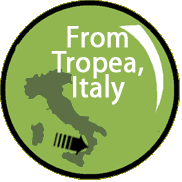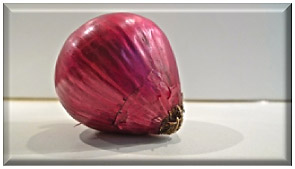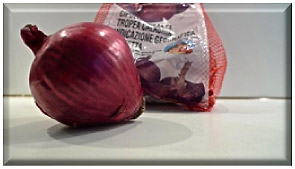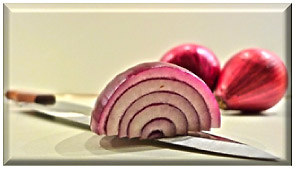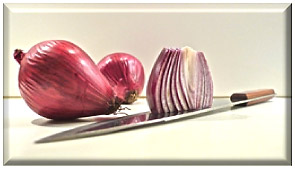 |
 |
|
 |
 |
||
|
Queen Viola Cipolla
of Tropea
Ever heard of Queen Viola Cipolla of Tropea? No? Well, in most, if not all Italian kitchens, Queen Viola Cipolla of Tropea, who hails from Calabria, is a member of an elite family. And that family is known here in the Bel Paese as the cipolla (onion), the "queen of the kitchen." Queen Viola Cipolla of Tropea just happens to be the peninsula's most prized onion and she's the color viola (purple). The Queen, along with her king, garlic - BAM! (Thank you Emeril) - are the royalty of the core ingredients found in la cucina Italiana.
Available year round, the new season of Queen Viola is seeded under the cool air of the fall in the fields around Golfo Vaticano (Vatican Golf), near the city of Tropea, overlooking the Calabrese stretch of the Tyrrhenian seacoast. In May-June she's harvested, and June-July she begins to hold court at countless open-air markets and the most popular supermarket chains throughout Italy and beyond. Unique among onions, in 2008 the European Union registered the regal Cipolla Rossa di Tropea (Red Onion of Tropea) under its Protected Designation of Origin (PDO) mark.
As a devoted subject, I happen to love Queen Viola. As my queen, she's sweet; so much so, they even make marmalade out of her. And best of all, my queen doesn't leave you running for mouthwash like most of her yellow or white-skinned relatives of the onion realm. I bow to her and pay homage whenever she's thinly sliced over fresh salads, grilled alongside meats and seafood, or skewered onto juicy and colorful spiedini (shish kebabs).
Whether you spend lots of time cooking or, like me, just carry around a good fork, I dare you to wipe off your cutting board and allow Queen Viola into your kitchen. She's Calabria's sweet-tasting, deep-purple royalty and really deserves a try the next time you reach for an onion.
Long live the Queen! Queen Viola Cipolla of Tropea, that is..
|
Hi Audrey, Love your lamb shanks. --- Paul, Scottsdale AZ
Haven't been called Tad for . . .gee, maybe I've NEVER been called Tad . . . guess I'm the only one with chutzpah enough to mention Bourdain. BRILLIANT? --- Ken, Shutesbury, MA
I think we must have had an entirely different experience in the UK. (Fresh Food and Real Ale – week 1). We were up in Edinburgh and they served something called ‘Neeps & Tatties.’ The items were boiled so long that I couldn’t even recognize what I was eating. Come to think of it… I couldn’t taste them either. Later I found that Neeps’ are Turnips and ‘Tatties’ are potatoes. --- Lindy, Phoenix, AZ
My mouth was watering as I read some of your descriptions of the fantastic fare of ... England? I had always felt smug about the lowly reputation of British cuisine as this gave us at least one country with a worse culinary reputation than America's. I guess I'll have to change my views. Your article made me actually want to take a CULINARY tour of Britain. Yummy yummy yummy. --- Sandy Miner, Portland, OR Thanks for your note. Thanks to Traveling Boy I get to interview a world famous chef this week who is widely recognized as spearheading the Yummy movement in Ireland. Guess I'll have to take yet another culinary tour a little further north and check it out... (I love my job!) --- Audrey
Very interesting, mouth-watering piece by Audrey! (A McDreamy McMeel). Your web site is fascinating! --- Susie, Victoria, BC
Combining travel, food, and intelligent advice -- BRILLIANT! Your site fills a long-felt need for hungry roamers. Keep it up! It's Anthony Bourdain with reservations and CLASS. --- Tad, Boston, MA
|
|
| |||
This site is designed and maintained by WYNK Marketing. Send all technical issues to: support@wynkmarketing.com

|








